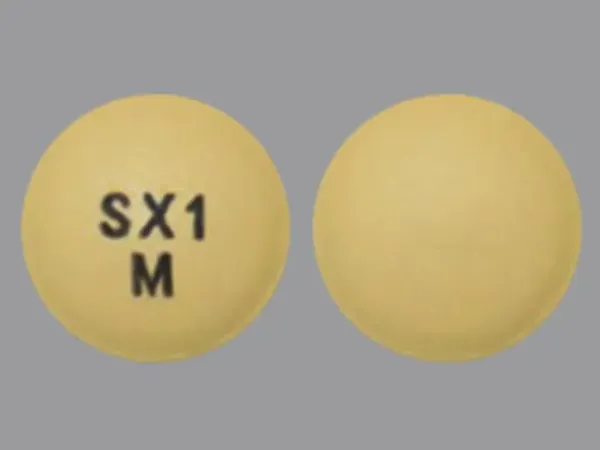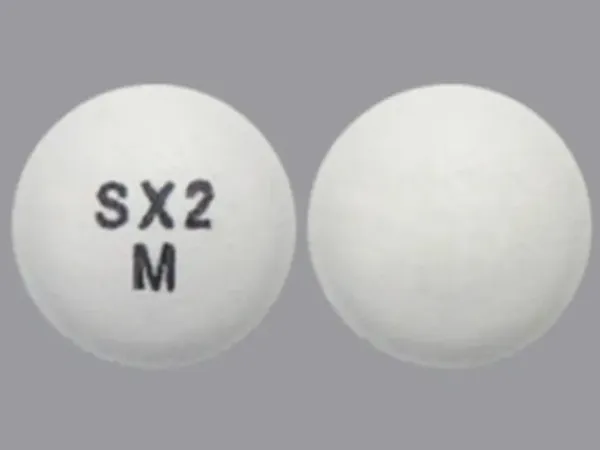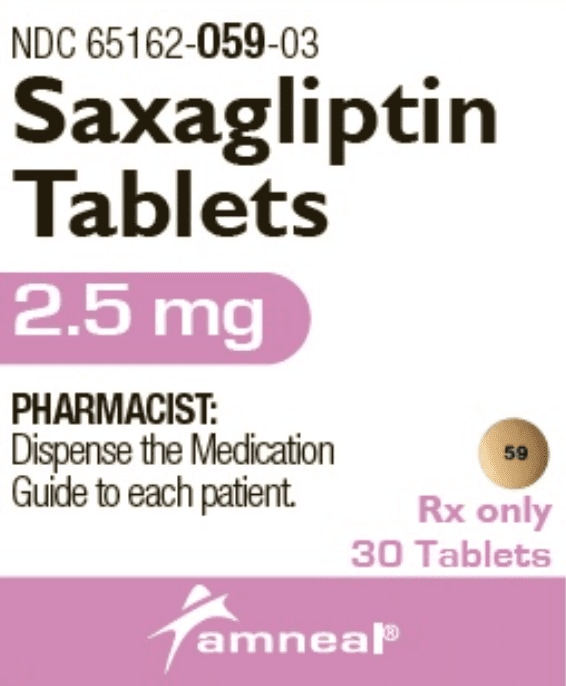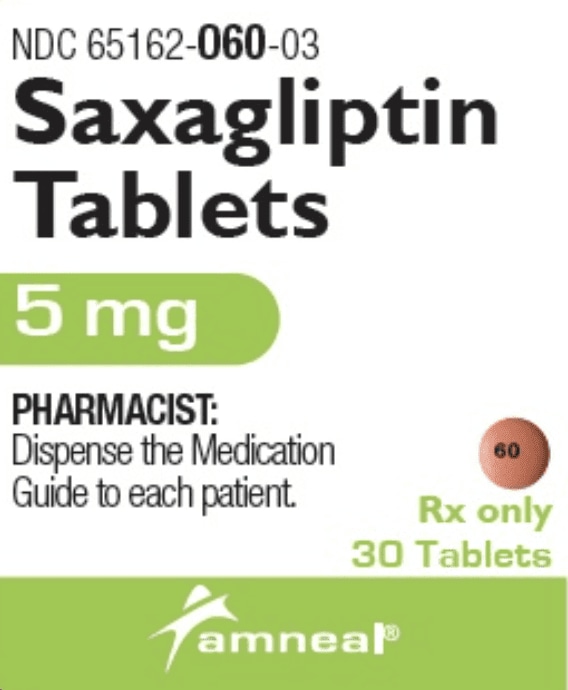Dosage Forms
Excipient information presented when available (limited, particularly for generics); consult specific product labeling.
Tablet, Oral:
Onglyza: 2.5 mg, 5 mg
Pharmacology
Mechanism of Action
Saxagliptin inhibits dipeptidyl peptidase IV (DPP-IV) enzyme resulting in prolonged active incretin levels. Incretin hormones (eg, glucagon-like peptide-1 [GLP-1] and glucose-dependent insulinotropic polypeptide [GIP]) regulate glucose homeostasis by increasing insulin synthesis and release from pancreatic beta cells and decreasing glucagon secretion from pancreatic alpha cells. Decreased glucagon secretion results in decreased hepatic glucose production. Under normal physiologic circumstances, incretin hormones are released by the intestine throughout the day and levels are increased in response to a meal; incretin hormones are rapidly inactivated by the DPP-IV enzyme.
Pharmacokinetics/Pharmacodynamics
Metabolism
Hepatic via CYP3A4/5 to 5-hydroxy saxagliptin (active; ~50% potency of the parent compound)
Excretion
Urine (75%, 24% of the total dose as saxagliptin, 36% of the total dose as 5-hydroxy saxagliptin); feces (22%)
Time to Peak
Plasma: Saxagliptin: 2 hours; 5-hydroxy saxagliptin: 4 hours
Duration of Action
24 hours
Half-Life Elimination
Saxagliptin: 2.5 hours; 5-hydroxy saxagliptin: 3.1 hours
Protein Binding
Negligible
Use in Specific Populations
Special Populations: Renal Function Impairment
AUC was up to 2.1- and 4.5-fold higher in patients with moderate or severe renal impairment. Dosage adjustment is required. In patients with mild renal impairment, AUC for saxagliptin and its active metabolite were 20% and 70% higher, respectively, which is not considered significant.
Special Populations: Hepatic Function Impairment
Cmax and AUC were 8% and 77% higher, respectively, in patients with hepatic impairment (Child-Pugh class A, B, and C). The corresponding Cmax and AUC of the active metabolite were 59% and 33% lower, respectively.
Use: Labeled Indications
Diabetes mellitus, type 2: As an adjunct to diet and exercise to improve glycemic control in adults with type 2 diabetes mellitus as monotherapy or in combination therapy.
Contraindications
Hypersensitivity (eg, anaphylaxis, angioedema, exfoliative skin conditions) to saxagliptin or any component of the formulation
Canadian labeling: Additional contraindications (not in US labeling): Hypersensitivity to another DPP-4 inhibitor; diabetic ketoacidosis, diabetic coma/precoma, type 1 diabetes mellitus
Dosage and Administration
Dosing: Adult
Diabetes mellitus, type 2: Oral: 2.5 to 5 mg once daily
Concomitant use with strong CYP3A4/5 inhibitors (eg, atazanavir, clarithromycin, indinavir, itraconazole, ketoconazole, nefazodone, nelfinavir, ritonavir, saquinavir, telithromycin): 2.5 mg once daily
Concomitant use with insulin or insulin secretagogues: Reduced dose of insulin or insulin secretagogues (eg, sulfonylureas) may be needed
Dosing: Geriatric
Refer to adult dosing.
Administration
Oral: May be administered without regard to meals. Swallow whole; do not split or cut tablets.
Dietary Considerations
Individualized medical nutrition therapy (MNT) is an integral part of therapy (ADA 2013).
Storage
Store at 20°C to 25°C (68°F to 77°F); excursions permitted between 15°C to 30°C (59°F to 86°F).
Saxagliptin Images
Drug Interactions
Alpha-Lipoic Acid: May enhance the hypoglycemic effect of Antidiabetic Agents. Monitor therapy
Androgens: May enhance the hypoglycemic effect of Blood Glucose Lowering Agents. Exceptions: Danazol. Monitor therapy
Angiotensin-Converting Enzyme Inhibitors: Dipeptidyl Peptidase-IV Inhibitors may enhance the adverse/toxic effect of Angiotensin-Converting Enzyme Inhibitors. Specifically, the risk of angioedema may be increased. Monitor therapy
Aprepitant: May increase the serum concentration of CYP3A4 Substrates (High risk with Inhibitors). Monitor therapy
Clofazimine: May increase the serum concentration of CYP3A4 Substrates (High risk with Inhibitors). Monitor therapy
Conivaptan: May increase the serum concentration of CYP3A4 Substrates (High risk with Inhibitors). Avoid combination
CYP3A4 Inducers (Strong): May decrease the serum concentration of SAXagliptin. Monitor therapy
CYP3A4 Inhibitors (Moderate): May increase the serum concentration of SAXagliptin. Monitor therapy
CYP3A4 Inhibitors (Strong): May increase the serum concentration of SAXagliptin. Management: Limit the saxagliptin dose to 2.5 mg daily when combined with strong CYP3A4 inhibitors. When using the saxagliptin combination products saxagliptin/dapagliflozin or saxagliptin/dapagliflozin/metformin, avoid use with strong CYP3A4 inhibitors. Consider therapy modification
Direct Acting Antiviral Agents (HCV): May enhance the hypoglycemic effect of Antidiabetic Agents. Monitor therapy
Duvelisib: May increase the serum concentration of CYP3A4 Substrates (High risk with Inhibitors). Monitor therapy
Erdafitinib: May increase the serum concentration of CYP3A4 Substrates (High risk with Inhibitors). Monitor therapy
Erdafitinib: May increase the serum concentration of P-glycoprotein/ABCB1 Substrates. Monitor therapy
Fosaprepitant: May increase the serum concentration of CYP3A4 Substrates (High risk with Inhibitors). Monitor therapy
Fosnetupitant: May increase the serum concentration of CYP3A4 Substrates (High risk with Inhibitors). Monitor therapy
Fusidic Acid (Systemic): May increase the serum concentration of CYP3A4 Substrates (High risk with Inhibitors). Avoid combination
Guanethidine: May enhance the hypoglycemic effect of Antidiabetic Agents. Monitor therapy
Hyperglycemia-Associated Agents: May diminish the therapeutic effect of Antidiabetic Agents. Monitor therapy
Hypoglycemia-Associated Agents: Antidiabetic Agents may enhance the hypoglycemic effect of Hypoglycemia-Associated Agents. Monitor therapy
Idelalisib: May increase the serum concentration of CYP3A4 Substrates (High risk with Inhibitors). Avoid combination
Insulins: Dipeptidyl Peptidase-IV Inhibitors may enhance the hypoglycemic effect of Insulins. Management: Consider a decrease in insulin dose when initiating therapy with a dipeptidyl peptidase-IV inhibitor and monitor patients for hypoglycemia. Consider therapy modification
Larotrectinib: May increase the serum concentration of CYP3A4 Substrates (High risk with Inhibitors). Monitor therapy
Lasmiditan: May increase the serum concentration of P-glycoprotein/ABCB1 Substrates. Avoid combination
Lumacaftor and Ivacaftor: May decrease the serum concentration of P-glycoprotein/ABCB1 Substrates. Lumacaftor and Ivacaftor may increase the serum concentration of P-glycoprotein/ABCB1 Substrates. Monitor therapy
Maitake: May enhance the hypoglycemic effect of Blood Glucose Lowering Agents. Monitor therapy
MiFEPRIStone: May increase the serum concentration of CYP3A4 Substrates (High risk with Inhibitors). Management: Minimize doses of CYP3A4 substrates, and monitor for increased concentrations/toxicity, during and 2 weeks following treatment with mifepristone. Avoid cyclosporine, dihydroergotamine, ergotamine, fentanyl, pimozide, quinidine, sirolimus, and tacrolimus. Consider therapy modification
Monoamine Oxidase Inhibitors: May enhance the hypoglycemic effect of Blood Glucose Lowering Agents. Monitor therapy
Netupitant: May increase the serum concentration of CYP3A4 Substrates (High risk with Inhibitors). Monitor therapy
Palbociclib: May increase the serum concentration of CYP3A4 Substrates (High risk with Inhibitors). Monitor therapy
Pegvisomant: May enhance the hypoglycemic effect of Blood Glucose Lowering Agents. Monitor therapy
P-glycoprotein/ABCB1 Inducers: May decrease the serum concentration of P-glycoprotein/ABCB1 Substrates. P-glycoprotein inducers may also further limit the distribution of p-glycoprotein substrates to specific cells/tissues/organs where p-glycoprotein is present in large amounts (e.g., brain, T-lymphocytes, testes, etc.). Monitor therapy
P-glycoprotein/ABCB1 Inhibitors: May increase the serum concentration of P-glycoprotein/ABCB1 Substrates. P-glycoprotein inhibitors may also enhance the distribution of p-glycoprotein substrates to specific cells/tissues/organs where p-glycoprotein is present in large amounts (e.g., brain, T-lymphocytes, testes, etc.). Monitor therapy
Prothionamide: May enhance the hypoglycemic effect of Blood Glucose Lowering Agents. Monitor therapy
Quinolones: May enhance the hypoglycemic effect of Blood Glucose Lowering Agents. Quinolones may diminish the therapeutic effect of Blood Glucose Lowering Agents. Specifically, if an agent is being used to treat diabetes, loss of blood sugar control may occur with quinolone use. Monitor therapy
Ranolazine: May increase the serum concentration of P-glycoprotein/ABCB1 Substrates. Monitor therapy
Ritodrine: May diminish the therapeutic effect of Antidiabetic Agents. Monitor therapy
Salicylates: May enhance the hypoglycemic effect of Blood Glucose Lowering Agents. Monitor therapy
Selective Serotonin Reuptake Inhibitors: May enhance the hypoglycemic effect of Blood Glucose Lowering Agents. Monitor therapy
Simeprevir: May increase the serum concentration of CYP3A4 Substrates (High risk with Inhibitors). Monitor therapy
Stiripentol: May increase the serum concentration of CYP3A4 Substrates (High risk with Inhibitors). Management: Use of stiripentol with CYP3A4 substrates that are considered to have a narrow therapeutic index should be avoided due to the increased risk for adverse effects and toxicity. Any CYP3A4 substrate used with stiripentol requires closer monitoring. Consider therapy modification
Sulfonylureas: Dipeptidyl Peptidase-IV Inhibitors may enhance the hypoglycemic effect of Sulfonylureas. Management: Consider a decrease in sulfonylurea dose when initiating therapy with a dipeptidyl peptidase-IV inhibitor and monitor patients for hypoglycemia. Consider therapy modification
Thiazide and Thiazide-Like Diuretics: May diminish the therapeutic effect of Antidiabetic Agents. Monitor therapy
Adverse Reactions
1% to 10%:
Cardiovascular: Peripheral edema (4%)
Central nervous system: Headache (7%)
Endocrine & metabolic: Hypoglycemia (6%)
Genitourinary: Urinary tract infection (7%)
Hematologic & oncologic: Lymphocytopenia (2%)
Hypersensitivity: Hypersensitivity reaction (2%; including facial edema and urticaria)
Frequency not defined: Cardiovascular: Thrombocytopenia
<1%, postmarketing, and/or case reports: Acute pancreatitis, anaphylaxis, angioedema, bullous pemphigoid, exfoliative dermatitis, immune thrombocytopenia, increased creatine phosphokinase in blood specimen, increased serum creatinine, pancreatitis, rhabdomyolysis, severe arthralgia
Warnings/Precautions
Concerns related to adverse effects:
- Arthralgia: Severe and disabling arthralgia has been reported with DPP-IV inhibitor use; onset may occur within one day to years after treatment initiation and may resolve with discontinuation of therapy. Some patients may experience a recurrence of symptoms if DPP-IV inhibitor therapy resumed.
- Bullous pemphigoid: DPP-4 inhibitor use has been associated with development of bullous pemphigoid; cases have typically resolved with topical or systemic immunosuppressive therapy and discontinuation of DPP-4 inhibitor therapy. Advise patients to report development of blisters or erosions. Discontinue therapy if bullous pemphigoid is suspected and consider referral to a dermatologist.
- Hematologic: Dose-related decrease in lymphocyte count has been observed; clinical significance is not known. Monitoring of lymphocyte counts may be warranted in patients with unusual or persistent infection.
- Hypersensitivity reactions: Hypersensitivity reactions, including anaphylaxis, angioedema, and exfoliative dermatologic reactions have been reported; discontinue if signs/symptoms of severe hypersensitivity reaction occur. Events have generally occurred within the first 3 months of therapy, and may occur after the initial dose. Use with caution if patient has experienced angioedema with other DPP-IV inhibitor use.
- Pancreatitis: Cases of acute pancreatitis have been reported with use. Monitor for signs/symptoms of pancreatitis; discontinue use immediately if pancreatitis is suspected and initiate appropriate management. Use with caution in patients with a history of pancreatitis as it is not known if this population is at greater risk.
Disease-related concerns:
- Bariatric surgery:
– Altered absorption: Absorption may be altered given the anatomic and transit changes created by gastric bypass and sleeve gastrectomy surgery (Mechanick 2013; Melissas 2013).
– Glucagon-like peptide-1 exposure and therapeutic efficacy: Closely monitor for signs and symptoms of pancreatitis; gastric bypass and sleeve gastrectomy may increase endogenous secretion of glucagon-like peptide-1 (Korner 2009; Peterli 2012). A single-dose, placebo-controlled study evaluated short-term therapy (4 weeks) with sitagliptin in gastric bypass patients having persistent or recurrent type 2 diabetes and found it to be well tolerated and provided a small but significant reduction in postprandial blood glucose (Shah 2018).
- Heart failure: Heart failure (HF) that may require hospitalization has been reported in a multi-center, randomized, double-blind, placebo-controlled trial in patients with type 2 diabetes with a history of, or at risk for, cardiovascular events; risk was increased in patients with preexisting heart failure or renal impairment and during the first 12 months of therapy (Scirica 2013; Scirica 2014). A population-based retrospective study in an ambulatory setting with relatively lower baseline cardiovascular risk factors failed to demonstrate increased risk in patients on saxagliptin compared to other agents (eg, sitagliptin, pioglitazone, sulfonylureas, insulin) (Toh 2016). Monitor for signs and symptoms of heart failure during therapy and consider discontinuation if condition develops. In a scientific statement from the American Heart Association, saxagliptin has been determined to be an agent that may exacerbate underlying myocardial dysfunction (magnitude: major) (AHA [Page 2016]). The ADA recommends avoiding use of saxagliptin in patients with HF (ADA 2019).
- Renal impairment: Use with caution in patients with moderate to severe renal dysfunction (eGFR <45 mL/minute/1.73 m2) including end-stage renal disease (ESRD) requiring hemodialysis; dosing adjustment required.
Concurrent drug therapy issues:
- Drug-drug interactions: Potentially significant interactions may exist, requiring dose or frequency adjustment, additional monitoring, and/or selection of alternative therapy. Consult drug interactions database for more detailed information.
Other warnings/precautions:
- Appropriate use: Not indicated for use in patients with type 1 diabetes mellitus or with diabetic ketoacidosis (DKA).
- Patient education: Diabetes self-management education (DSME) is essential to maximize the effectiveness of therapy.
Monitoring Parameters
Plasma glucose, HbA1c (at least twice yearly in patients who have stable glycemic control and are meeting treatment goals; quarterly in patients not meeting treatment goals or with therapy change [ADA 2019]), renal function (prior to initiation of therapy and periodically thereafter); lymphocyte counts (if unusual or persistent infection); signs/symptoms of pancreatitis and/or heart failure
Pregnancy
Pregnancy Considerations
Poorly controlled diabetes during pregnancy can be associated with an increased risk of adverse maternal and fetal outcomes, including diabetic ketoacidosis, preeclampsia, spontaneous abortion, preterm delivery, delivery complications, major birth defects, stillbirth, and macrosomia. To prevent adverse outcomes, prior to conception and throughout pregnancy, maternal blood glucose and HbA1c should be kept as close to target goals as possible but without causing significant hypoglycemia (ADA 2020; Blumer 2013).
Agents other than saxagliptin are currently recommended to treat diabetes mellitus in pregnancy (ADA 2020).
Patient Education
What is this drug used for?
- It is used to lower blood sugar in patients with high blood sugar (diabetes).
Frequently reported side effects of this drug
- Headache
- Common cold symptoms
Other side effects of this drug: Talk with your doctor right away if you have any of these signs of:
- Urinary tract infection like blood in the urine, burning or painful urination, passing a lot of urine, fever, lower abdominal pain, or pelvic pain.
- Low blood sugar like dizziness, headache, fatigue, feeling weak, shaking, a fast heartbeat, confusion, hunger, or sweating.
- Pancreatitis like severe abdominal pain, severe back pain, severe nausea, or vomiting.
- Heart problems like cough or shortness of breath that is new or worse, swelling of the ankles or legs, abnormal heartbeat, weight gain of more than five pounds in 24 hours, dizziness, or passing out.
- Difficulty swallowing
- Skin blisters
- Skin breakdown
- Persistent joint pain
- Severe joint pain
- Signs of a significant reaction like wheezing; chest tightness; fever; itching; bad cough; blue skin color; seizures; or swelling of face, lips, tongue, or throat.
Note: This is not a comprehensive list of all side effects. Talk to your doctor if you have questions.
Consumer Information Use and Disclaimer: This information should not be used to decide whether or not to take this medicine or any other medicine. Only the healthcare provider has the knowledge and training to decide which medicines are right for a specific patient. This information does not endorse any medicine as safe, effective, or approved for treating any patient or health condition. This is only a brief summary of general information about this medicine. It does NOT include all information about the possible uses, directions, warnings, precautions, interactions, adverse effects, or risks that may apply to this medicine. This information is not specific medical advice and does not replace information you receive from the healthcare provider. You must talk with the healthcare provider for complete information about the risks and benefits of using this medicine.








